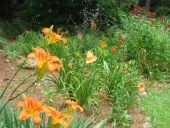Some red elm
trees yield a slippery cadmium of the bark, (don't kill the trunk, use the green limbs if possible) it is good to eat, & other uses, if properly dried the inner bark can be easily stored & later reconstituted with water. They generally make tall narrow trees with lots of shade, you may already have some, just need to ID them if so, they generally don't get diseased & die like some of the other elms.
I love elephant ears to look at, but it you have lots of them maybe you can trade some for plants you want.
Grape vines do pretty well next to a river and seasonal floods probably won't bother them much.
Spicebush is a shrub that grows in full shade, moist ground, crush the leaves and smear the fragrance on your skin as mosquito repellant, also some people use the leaves to make strong tea (tastes kind of like kerosene) hahaa, the berries can be kind of sparse, but when properly dried the husk of the berry is used as spice.
Paw Paw makes a deep shade under it, it often grows in thickets, is often used for erosion control because of the deep tap root, the fruit is kind of strange tasting but edible, and pretty tolerable if frozen in ice cream, the fruit is sparse & doesn't store well.
Blackberries grow along a creek/sandy areas well, get the thornless (non-native) kind if possible, but they need a spot that won't get the thicket trampled often.(maybe
fence off a plot)
I can't see eating a cattail, but hey if you like 'em, sounds like you got it made.
Sassafras leaves eat pretty good right off the tree, and if you dry the leaves properly they store well & you can make spice out of them.
james beam








